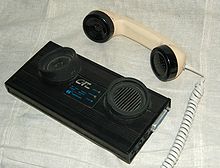Modem
From Wikipedia, the free encyclopedia

A modem (modulator-demodulator) is a device that modulates an analog carrier signal to encode digital information, and also demodulates such a carrier signal to decode the transmitted information. The goal is to produce a signal that can be transmitted easily and decoded to reproduce the original digital data. Modems can be used over any means of transmitting analog signals, from driven diodes to radio.
The most familiar example is a voiceband modem that turns the digital data of a personal computer into analog audio signals that can be transmitted over a telephone line, and once received on the other side, a modem converts the analog data back into digital.
Modems are generally classified by the amount of data they can send in a given time, normally measured in bits per second (bit/s, or bps). They can also be classified by Baud, the number of times the modem changes its signal state per second. For example, the ITU V.21 standard used audio frequency-shift keying, aka tones, to carry 300 bit/s using 300 baud, whereas the original ITU V.22 standard allowed 1,200 bit/s with 600 baud using phase-shift keying.
Faster modems are used by Internet users every day, notably cable modems and ADSL modems. In telecommunications, wide-band radio modems transmit repeating frames of data at very high data rates over microwave radio links. Narrow-band radio modem is used for low data rate up to 19.2k mainly for private radio networks. Some microwave modems transmit more than a hundred million bits per second. Optical modems transmit data over optical fibers. Most intercontinental data links now use optical modems transmitting over undersea optical fibers. Optical modems routinely have data rates in excess of a billion (1x109) bits per second. One kilobit per second (kbit/s, kb/s, or kbps) as used in this article means 1,000 bits per second and not 1,024 bits per second. For example, a 56k modem can transfer data at up to 56,000 bit/s (7 kB/s) over the phone line.
In the summer of 1960,the name Data-Phone was introduced to replace the earlier term digital subset. The 202 Data-Phone was a half-duplex asynchronous service that was marketed extensively in late 1960. In 1962, the 201A and 201B Data-Phones were introduced. They were synchronous modems using two-bit-per-baud phase-shift keying (PSK). The 201A operated half-duplex at 2,000 bit/s over normal phone lines, while the 201B provided full duplex 2,400 bit/s service on four-wire leased lines, the send and receive channels running on their own set of two wires each.
The famous Bell 103A dataset standard was also introduced by Bell Labs in 1962. It provided full-duplex service at 300 baud over normal phone lines. Frequency-shift keying was used with the call originator transmitting at 1,070 or 1,270 Hz and the answering modem transmitting at 2,025 or 2,225 Hz. The readily available 103A2 gave an important boost to the use of remote low-speed terminals such as the KSR33, the ASR33, and the IBM 2741. AT&T reduced modem costs by introducing the originate-only 113D and the answer-only 113B/C modems.
The Carterfone decision
For many years, the Bell System (AT&T) maintained a monopoly on the use of its phone lines, allowing only Bell-supplied devices to be attached to its network. Before 1968, AT&T maintained a monopoly on what devices could be electrically connected to its phone lines. This led to a market for 103A-compatible modems that were mechanically connected to the phone, through the handset, known as acoustically coupled modems. Particularly common models from the 1970s were the Novation CAT and the Anderson-Jacobson, spun off from an in-house project at the Lawrence Livermore National Laboratory. Hush-a-Phone v. FCC was a seminal ruling in United States telecommunications law decided by the DC Circuit Court of Appeals on November 8, 1956. The District Court found that it was within the FCC's authority to regulate the terms of use of AT&T's equipment. Subsequently, the FCC examiner found that as long as the device was not physically attached it would not threaten to degenerate the system. Later, in the Carterfone decision of 1968, the FCC passed a rule setting stringent AT&T-designed tests for electronically coupling a device to the phone lines. AT&T made these tests complex and expensive, so acoustically coupled modems remained common into the early 1980s.

Tidak ada komentar:
Posting Komentar